Characteristics of Recent and Established EEA and non-EEA migrants in Scotland: Analysis of the 2011 Census
This report presents findings from analysis of the 2011 Census on characteristics and experiences of recent and established migrants from EEA and non-EEA countries living in Scotland.
3. Area and accommodation
Council area distribution
The council areas with the highest proportion of people born outside of the UK were Aberdeen City and Edinburgh City (both 16 per cent; Aberdeen 35,500, Edinburgh 75,800), and Glasgow City (12 per cent; 72,700). See Annex Table A4 for full detail for all council areas.
Chart 3.1 shows that half (50 per cent) of all migrants lived in these three large city council areas. Migrants who had arrived recently were proportionally more likely to live in the three large city council areas. Nearly two-thirds (64 per cent) of recent non-EEA migrants lived here, compared to two-fifths (40 per cent) of established non-EEA migrants. The high proportion of migrants in these areas may be associated with the number of higher education institutions in these council areas.
Compared to non-EEA migrants, a smaller proportion of EEA migrants overall lived in these large city council areas, but similar to non-EEA migrants, those having arrived recently (50 per cent) were more likely to live in these council areas than those who had arrived 10 years ago, or longer (31 per cent).
Chart 3.1. Migrants living in Aberdeen City, Edinburgh City, and Glasgow City council areas.
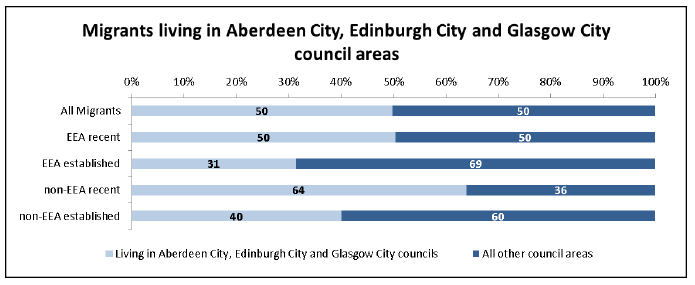
Source: 2011 Census, National Records of Scotland
Chart 3.2 shows that the origin of migrants was different in the different city council areas. The region of origin of migrants was noticeably different in Glasgow City council. Here nearly half (48 per cent) of migrants had a non-EEA recent arrival background, and only 8 per cent were established EEA migrants. The relative large proportion of non-EEA migrants in Glasgow may be associated with Glasgow being the main provider in Scotland for accommodation for asylum seekers.
Aberdeen had relatively large proportions of recent arrivals, both from EEA and non-EEA countries, whereas in Edinburgh the difference in the proportion of recent and established migrants was less pronounced.
Chart 3.2. Migrant origin within Aberdeen City, Edinburgh City and Glasgow City council areas.
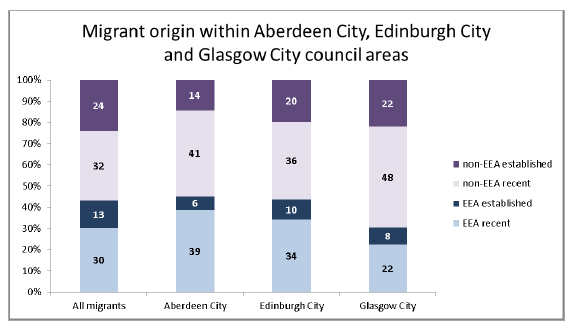
Source: 2011 Census, National Records of Scotland
In addition to the three largest cities as described above, compared to other council areas, Dundee had a relatively large proportion of recent non-EEA migrants (37 per cent). East Renfrewshire and East Dunbartonshire both had fewer migrants overall, with relatively large proportions of established non-EEA migrants (51 per cent in both council areas). Recent EEA migrants represented the largest proportion of migrants in the Shetland Isles (45 per cent) and West Lothian (42 per cent).
Urban/rural classification
Four in five (81 per cent) migrants lived in large, or other, urban areas. Nearly three quarters (73 per cent) of recent non-EEA migrants lived in large urban areas, and a further 16 per cent lived in other urban areas (Chart 3.3).
Established migrants were the least likely to live in large urban areas (established EEA - 43 per cent, established non-EEA - 53 per cent), and the most likely to live in accessible and remote rural areas (established EEA - 30 per cent, established non-EEA - 24 per cent).
Chart 3.3. Residence in rural and urban locations, all migrants
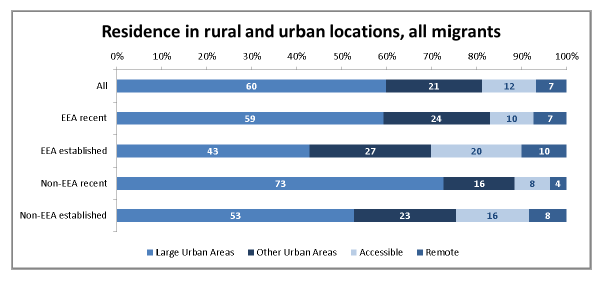
Source: 2011 Census, National Records of Scotland. Note: table shows small towns and rural combined for accessible and remote categories.
Area deprivation
The Scottish Index of Multiple Deprivation (SIMD) provides an index of multiple deprivation for geographic areas in Scotland.
Figure 3.1. shows that migrants were proportionally most likely to live both in the least deprived (SIMD 10) and most deprived areas (SIMD 1). Non-EEA migrants (15 per cent) were more likely to live in the least deprived areas than EEA migrants (11 per cent), and EEA migrants were proportionally more likely to live in the two most deprived deciles combined (23 per cent of EEA migrants, 18 per cent of non-EEA migrants.
Figure 3.1. EEA and non-EEA migrants living in each SIMD decile.
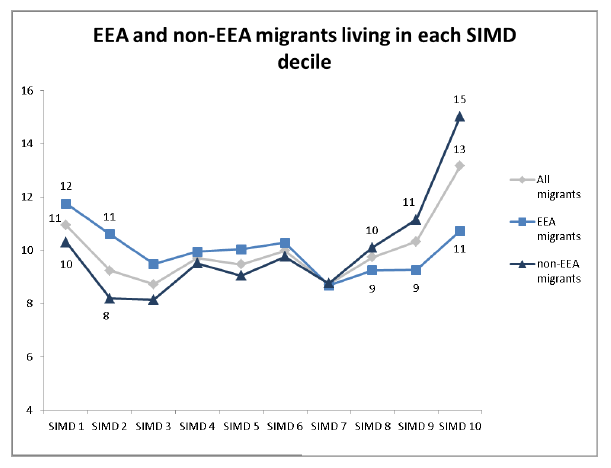
Source: 2011 Census, National Records of Scotland
Established migrants were twice as likely to live in the least deprived areas (15 per cent) than in the most deprived areas (7 per cent). Recent migrants were proportionally most likely to live both in the most deprived (13 per cent) and in the least deprived areas (12 per cent), see Figure 3.2.
Figure 3.2. Recent and established migrants living in each SIMD decile.
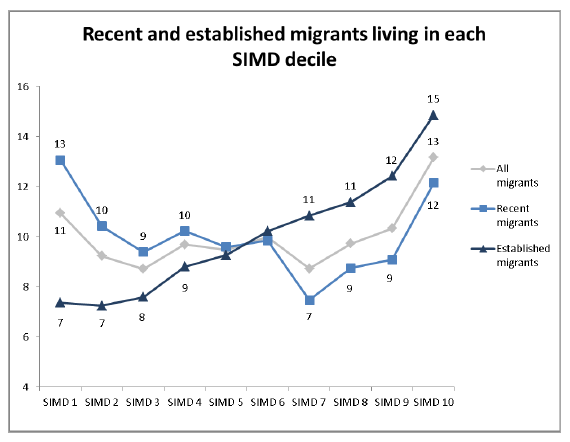
Source: 2011 Census, National Records of Scotland
As can be seen from Figure 3.3, recent migrants who arrived in Scotland 'between 2 and 5 years' and 'between 5 and 10 years' before the 2011 Census, were distributed more equally across the SIMD deciles.
Recent migrants who arrived in the 2 years up to the Census were proportionally most likely to live in the least deprived areas (16 per cent) and least likely compared to other migrants to live in the most deprived areas (9 per cent).
Figure 3.3. Recent migrants and length of residence in the UK living in each SIMD decile, all recent migrants.
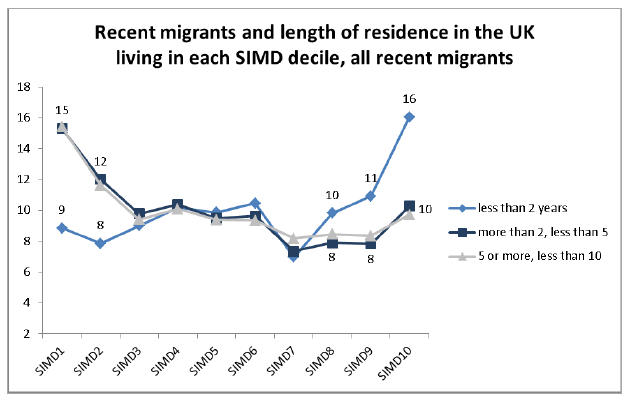
Source: 2011 Census, National Records of Scotland
Housing tenure
Chart 3.4. shows that the housing tenure of migrants was notably different to that of the Scottish population as a whole[7]. Migrants were three times more likely than the population as a whole to live in privately rented[8] housing (40 compared to 13 per cent) and were less likely to own their property (43 per cent of migrants compared to 66 per cent of the population) or live in social rented housing (17 per cent compared to 21 per cent).
Recent migrants, both from EEA and non-EEA countries, were most likely to live in private rented housing and less likely to own their property than established migrants. This may reflect the higher proportion of students within these groups (see Chart 4.3).
Tenure of established EEA and established non-EEA migrants was more similar to that of the population as a whole, albeit with somewhat higher levels of home ownership and lower levels of social renting.
Chart 3.4. Housing tenure, all migrants in households
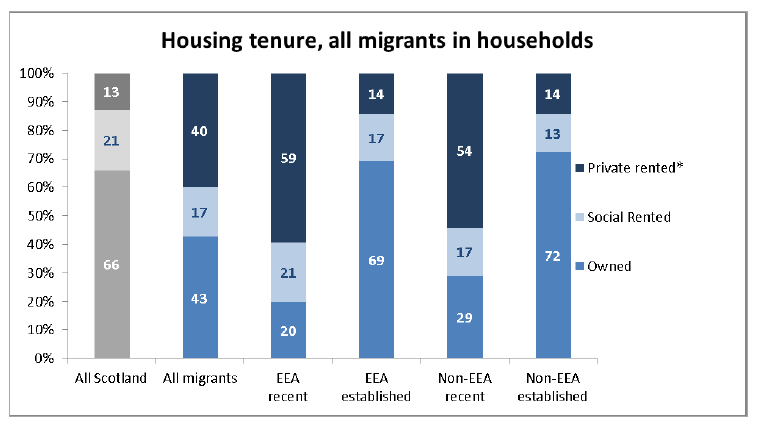
Source: 2011 Census, National Records of Scotland. Note: * private rented includes 'other' and 'living rent free'
It is likely that housing tenure is associated with length of residence. Figure 3.4 shows a clear pattern of fewer people in privately rented housing and higher house ownership with increased length of residence in the country. The proportion of people in social rented accommodation was not related to length of residence in a particular way.
Figure 3.4. Housing tenure and length of residence, all migrants in households
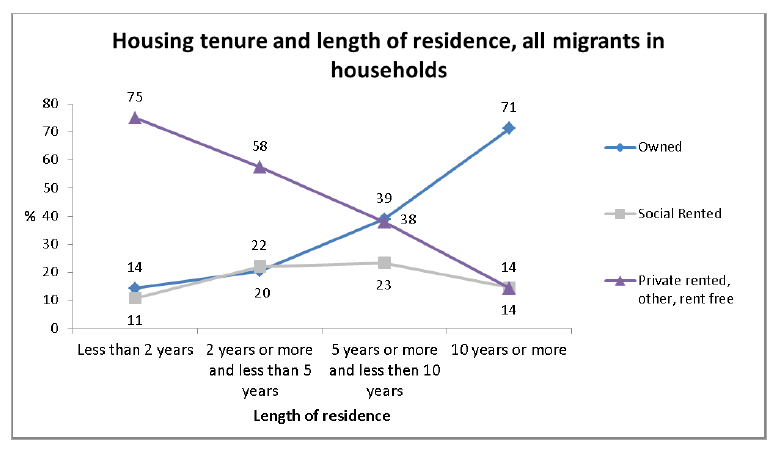
Source: 2011 Census, National Records of Scotland
Contact
Email: Wendy van Rijswijk
There is a problem
Thanks for your feedback